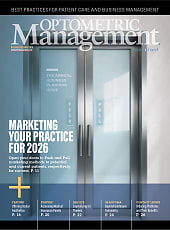The Business of Contact Lenses
Billing for an Amniotic Membrane Contact Lens
BY CLARKE D. NEWMAN, OD, FAAO

Human amniotic membranes are used by ophthalmologists and optometrists to treat many different ocular surface disorders. Since 2011, there have been new codes for the placement of an amniotic membrane on the eye. Originally, these amniotic membrane contact lenses (AMCLs) were usually sutured to the eye. Newer AMCLs with self-retaining rings and contact lens overlays have now come to the market, and the codes were modified to reflect these changes.
CPT was amended to add the 65778 code. The text for this code was “Placement of amniotic membrane on the ocular surface for wound healing, self-retaining.” In 2014, the text of the 65778 code was changed to, “Placement of amniotic membrane on the ocular surface for wound healing, without sutures.”
The reason for this change is that there are now membranes available that do not require suture fixation. Bio-Tissue, Inc.’s ProKera Biologic Corneal Bandage is fixated by the attachment of a 16.0mm polycarbonate ring. This lens is placed on the eye. After a therapeutic period of five to 10 days, during which the membrane dissolves, the ring is removed. ProKera is available in two thicknesses. The ProKera lens is shipped and stored in a near frozen state.
IOP Ophthalmics’ AmbioDisk comes in a 15.0mm disk that is covered with an 18.0mm scleral lens. The AmbioDisk is also available in two thicknesses. It is shipped and stored in a dehydrated state that can be stored at room temperature. The therapeutic period for the AmbioDisk is 10 to 14 days, during which the membrane dissolves under the lens. The scleral lens is then removed. An alternative method for placement of the AmbioDisk is to use tissue glue.
Lens Placement
Placement of AMCLs is relatively easy. It is best to always use aseptic technique in preparing and applying an AMCL.
For the ProKera, take the lens out of the freezer and let it warm up for five minutes. Next, cut the inner pouch open to remove the lens. Some practitioners use a lid speculum and forceps for application, some use their hands. Take care not to damage the membrane during the preparation and application. Always use topical anesthesia and antibiotic drops.
For the AmbioDisk, you must hydrate the lens. It is best to apply it under anesthesia. During the treatment period, antibiotics and often steroid therapy are indicated as well. For the AmbioDisk, a large scleral lens is often used to hold the AMCL in place.
Proper Billing Codes
AMCLs are indicated in many conditions that include non-healing corneal defects or recurrent erosions. The crosswalk code set for this condition includes corneal ulcer (370.00), corneal scar (371.00), corneal degeneration (371.40), recurrent corneal erosion (371.42), and corneal dystrophy (371.52). Other conditions for which an AMCL is a rational treatment include non-healing defects and ulcers, Stevens-Johnson syndrome, chemical burns, bullous keratopathy, and superficial keratectomy.
Billing for these lenses involves the 65778 CPT Code. In a practice setting, the reimbursement includes the cost of the membrane. For hospital-based practices, the physician is reimbursed separately and the lens is part of the facility fee. The global period for this code is 10 days. Use the –RT or the –LT modifiers to distinguish the eye on which you are placing the lens. You should have documentation in the record that other therapies did not work. CLS
Dr. Newman has been in private practice in Dallas, Texas since 1986 specializing in vision rehabilitation through contact lenses as well as corneal disease management, optometric medicine, and refractive surgery. He is a Diplomate in the AAO and a consultant to B+L and AMO. Contact him at cdnewman@earthlink.net.



